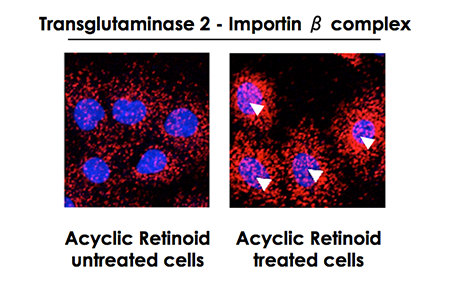Liver cancer is the most feared cancer because of its low survival rate after the initial treatment. The five-year relative survival rate is as low as 27.9 %, leading death of around 30 thousand people every year in Japan (Cancer statistics in Japan, 2014). Hepatocellular carcinoma is the most typical liver cancer with a very high recurrence rate. It commonly occurs with infections of hepatitis B or C virus, overdoses of ethanol or free fatty acid that accompany liver cirrhosis. Acyclic retinoid (Generic Name: Peretinoin, Kowa Company, Ltd.) is a synthetic derivative of vitamin A, which has been demonstrated in clinical trials to show the chemotherapeutic activity selectively killing liver cancer precursor cells and preventing recurrence of the hepatocellular carcinoma.
[caption id="attachment_2714" align="alignright" width="465"] Red fluorescence dots derived from Transglutaminase 2 / importin-α / importin-β complex were monitored with blue fluorescence of nuclei[/caption]
Red fluorescence dots derived from Transglutaminase 2 / importin-α / importin-β complex were monitored with blue fluorescence of nuclei[/caption]
A research group lead by a Special Unit Leader, Soichi Kojima, RIKEN Center for Life Science Technologies, formerly reported an interesting finding about acyclic retinoid. The group found that the chemotherapeutic agent induces nuclear localization of a protein cross-linking enzyme transglutaminase 2, which would otherwise normally present in the cytoplasm. In the nucleus, the enzyme causes an excessive cross-linking of transcription factor Sp1. As a result, the expression of the growth factors receptors essential for the survival of cancer cells is impaired at the transcriptional level leading to cell death of cancer cells. However, the role of acyclic retinoid in nuclear localization of transglutaminase 2 was unknown. This time, the group reported a molecular basis for nuclear-cytoplasmic transport of transglutaminase 2 and a role of acyclic retinoid in it.
FigureRed fluorescence dots derived from Transglutaminase 2 / importin-α / importin-β complex were monitored with blue fluorescence of nuclei
Transglutaminase 2 consists of a β sandwich (A domain), enzymatically active core (B domain), β barrel 1 (C domain), and β-barrel 2 (D domain). In their studies, the researchers overexpressed fluorescent tagged transglutaminase 2 mutant proteins in a hepatocellular carcinoma cells line and monitored cellular distribution of the overexpressed proteins under fluorescence microscope. They found that treatment of the cells with acyclic retinoid induced nuclear accumulation of the mutant protein at 4-6 hours and subsequent cell death at 6-10 hours after starting the treatment. The researchers overexpressed fluorescent tagged transglutaminase 2 mutant proteins lacking domains(s) in the hepatocellular carcinoma cells. This helped them to identify a novel yet functional 14 amino acid nuclear localization signal “AEKEETGMAMRIRV” at the beginning of the ‘C’ domain as well as 8 amino acids leucine-rich nuclear export sequences “LHMGLHKL” at the ‘D’ domain of transglutaminase 2. They observed that the nuclear localization signal in transglutaminase 2 interacts with importin α3 and importin β enabling transglutaminase 2/importin α /importin β complex to import inside nucleus and identified nuclear export sequence interacts with exportin-1 enabling to translocate back to cytoplasm. Interestingly the group also found that acyclic retinoid increased formation of the transglutaminase 2 nuclear localization signal /importin α/ importin-β trimeric complex, hence increasing nuclear localization of transglutaminase 2 and leading to cell death.
The research team is now exploring the molecular mechanism unraveled in this study and establishing the chemical screening to find new potential drug candidates. A chemical compound that enhances the nuclear translocation of TG2 is expected to selectively kill hepatic cancer cells. On the other hand, a chemical compound that inhibits the nuclear translocation is expected to prevent liver failure in clinical conditions like alcoholic steatohepatitis and non-alcoholic steatohepatitis where induction of nuclear localization of transglutaminase 2 in normal hepatic cells has been implicated in their pathogenesis.
Press release in Japanese is HERE
